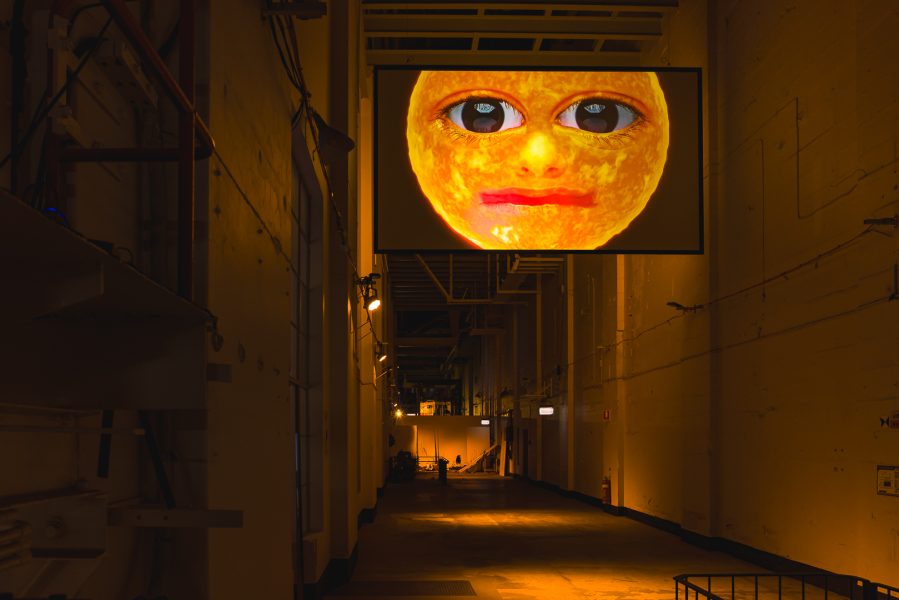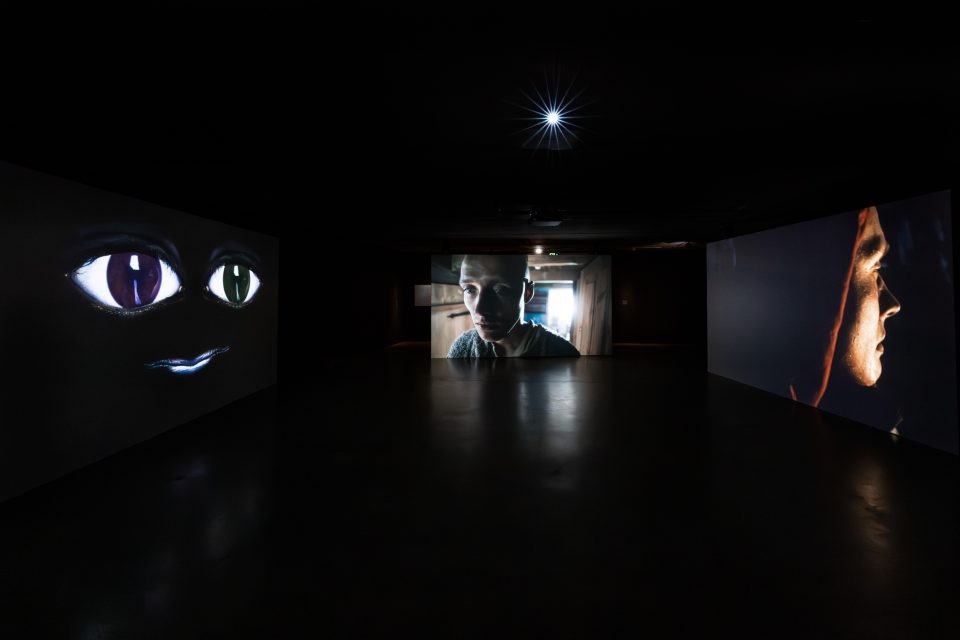White Bay Power Station
The New Sun, 2017
video and sound Installation
single video channel with stereo sound
12 minutes 20 seconds
Courtesy the artist
A personified Sun lectures his captive audience – planet Earth – through a series of love poems, stand-up comedy routines, and ominous pronouncements. Coercing its audience into a trance, the film “is about an observer who influences events through the act of observation”.
Projected on a large scale, the Sun’s child-like face evokes ideas of naivety and trustworthiness despite its occasionally menacing sentiments. Creating an experience that is both mesmerising and unnerving, Agnieszka Polska lulls her audience into an uneasy or involuntary meditation.
Deploying the same techniques used in advertisements, cult religions, and political campaigns, The New Sun complicates the relationship between observation and influence.
At times, the perspective shifts and the face is replaced with blurred footage of daily life. “Take a look,” the audience is told. “We are observing the world from within a watch”, becoming witness, as the Sun is, to a reality where the clock is running down.
UNSW Galleries
The Demon’s Brain, 2018
video and sound installation
4 video channels with stereo sound
7 minutes 24 seconds
Courtesy the artist and Georg Kargl Gallery
Film by Agnieszka Polska
Produced by Freunde der Nationalgalerie
Production Designer – Lynhan Balatbat-Helbock
Production Manager – Dagmara Konsek
Messenger – Bartosz Bielenia
Demon – Caroline Faber
Serafin – Olin Gutowski
Peasants – Daniel Milnes, Lutz Driever, Sven Beckstette, Rafał Nowak, Jacek Alichniewicz, Sebastian Zygowski, Mariusz Kazimierski
Director of Photography – Michał Dymek
Focus Puller – Piotr Kwiatkowski
Camera Assistant – Michał Cholewiński
Location Sound – Jan Moszumański
Sound Assistant – Jakub Rożej
Costume Designers – Aga Klepacka and Maciek Chorąży
Make-up Artist – Aleksandra Dutkiewicz
Hair Stylist – Kacper Raczkowski
Set Manager – Janusz Dąbkiewicz
Steadicam Operator – Marcin Guzak
Drone Operator – Vadim d’Erceville
Lighting Gaffer – Pawel Szastak
Lighting Assistant – Michał Michalski
Stuntwoman – Ewa Polska
Horse Trainer – Aleksandra Ring
Forest Ranger – Paweł Dobies
Special thanks to:
Wieliczka Salt Mine
Grzegorz Gust and the Szubin Forestry Management
Ethnographic Museum in Toruń
Fire Brigade of Nakło by Noteć
Sound Design – Igor Kłaczyński
Music Score – Igor Kłaczyński, based on “White Hill – Maromi’s Theme” by Susumu Hirasawa
Studio Sound – Thomas Wallmann
Animation – Agnieszka Polska
Character Animation and Lip Sync – Nathan Gray
Color correction Gregor Pfüller
The correspondence of Mikołaj Serafin belongs to the collection of National Library in Wrocław, and was published by Societas Vistulana as “Korespondencja żupnika krakowskiego Mikolaja Serafina z lat 1437-1459′, Kraków 2006, ed. Waldemar Bukowski, Tomasz Półciennik, Anna Skolimowska.
A messenger boy rides from the salt mines of 15th-century Poland, when he is confronted by a disembodied demon in the woods. Espousing Christian theology, contemporary concerns regarding resource consumption, environmental destruction, and data capital, Agnieszka Polska’s demon tasks the boy with preventing the apocalyptic-sounding future viewers know will transpire. There is an unbroken link between this story of exploitation in the European mainlands – set in the century that saw the beginnings of European colonisation of the world – and the later centuries of accelerating capitalism based on extractivism and subjugation of distant lands.
Drawing parallels between the collapse of the historical salt mining industry and the machinations of modern capitalism, The Demon’s Brain grapples with the question of individual responsibility in the information age. While demons are traditionally seen as malevolent spirits, in computer science ‘daemon’ refers to background processes that invisibly manipulate user experiences. Much how AI, a kind of daemon, is commonly perceived as an inhuman invention, Polska argues it is only an extension of existing social structures and divisions of labour.

